Ready For Japan! Vol. 13 – Japan Quiz: Are You An Expert Or An Amateur?

Are you planning on visiting Japan in the future or just curious about testing your knowledge of the country? If so, this quiz is for you! This quiz contains seven questions ranging from beginner to advanced level. If you get a perfect score, you're probably an expert on all things Japanese!
Take This Quiz and Learn More About Japan!
For this article, we’ve made a short quiz to test your knowledge on Japan. There are a total of seven questions, from beginner to advanced level, ranging on topics of culture, food, and more. See how many questions you can answer below.
Beginner Level
First up are the easiest questions. Have you ever traveled to Japan? If yes, then you’ll most likely answer the following:
Q1: What is visible from the Shinkansen window when traveling From Tokyo to Osaka?
| 1 | Kaminarimon (Thunder Gate) in Asakusa |
| 2 | Itsukushima Shrine’s Floating Torii Gate |
| 3 | Mt. Fuji |
| 4 | Himeji Castle |
A famous Japanese landmark can be seen outside the Shinkansen when traveling from Tokyo to Osaka and Kyoto. Which is the correct answer out of the four choices above?
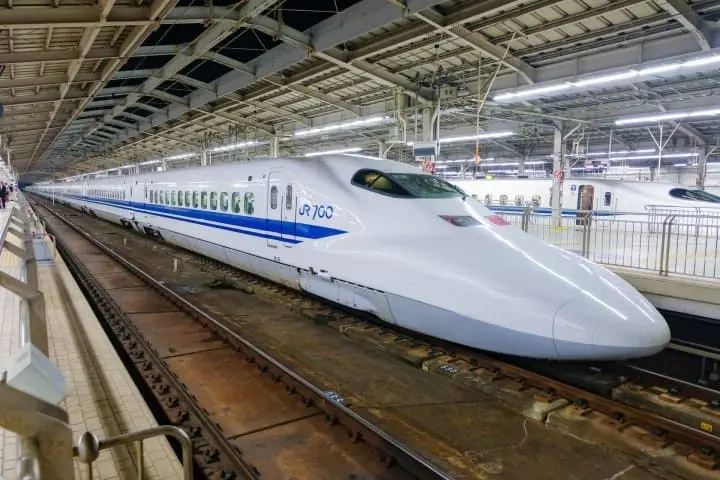
The Shinkansen (bullet train) is a convenient method of transportation for your travels in Japan.
The Tokaido Shinkansen connects Osaka and Tokyo in two and a half hours on the Nozomi bullet train service. A bullet train ride is a very efficient way to travel around the Tokyo, Osaka, and Kyoto areas.
The time on the train is another fun feature when traveling. Snack cart services are available inside the Shinkansen, and passengers can purchase bento lunchboxes, snacks, and drinks. You can also find a variety of prepackaged lunches of different varieties called ekiben sold at stalls in the station.
While enjoying your lunch, look out the window and a certain sight will unexpectedly come into view.
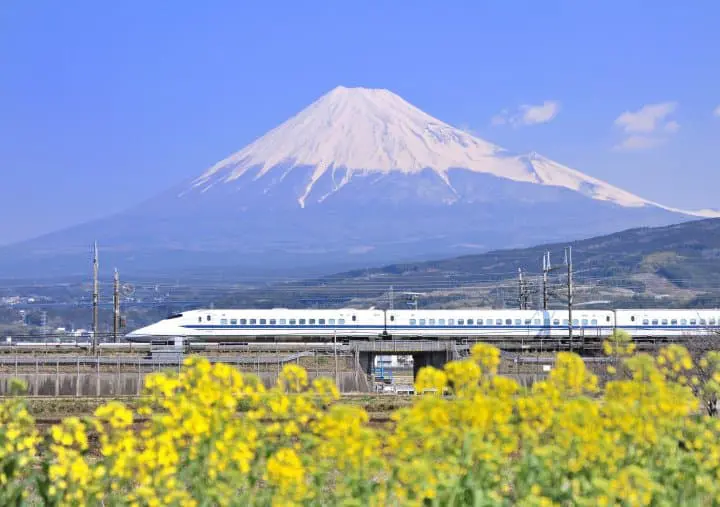
Photo by Pixta
That’s right, it’s Mt. Fuji! On clear days, Mt. Fuji can be seen from the train at several points during your journey between Mishima Station and Shin-Fuji Station.
By the way, make sure to reserve seat E if you want a clear view of Mt. Fuji from the Shinkansen. This seat faces Mt. Fuji whether you’re heading to Osaka and Kyoto or heading back to Tokyo. Sometimes clouds will cover the peak depending on the weather, making the mountain hardly visible. If you’re able to see Mt. Fuji, you should believe that Lady Luck is on your side.
Q2: What is “Nice to Meet You!” in Japanese?
| 1 | こんにちは! Konnichiwa! |
| 2 | はじめまして! Hajimemashite! |
| 3 | ありがとう! Arigato! |
| 4 | さようなら! Sayonara! |
When meeting someone for the first time, it's customary to say, "Nice to meet you!" What’s the equivalent of this greeting in Japanese from the four choices above?

The correct answer is choice 2: “Hajimemashite!” Listen to the audio below to learn how to pronounce it.
“Hajimemashite” is used only when meeting someone for the first time. Any time you see them after that, you can use “konnichiwa” as a greeting. MATCHA has several articles introducing handy Japanese phrases that you can listen to and learn how to pronounce. Become familiar with Japanese at home and use these phrases on your next trip to Japan!
Q3: What do these things have in common?
What do the following four ingredients pictured below share?
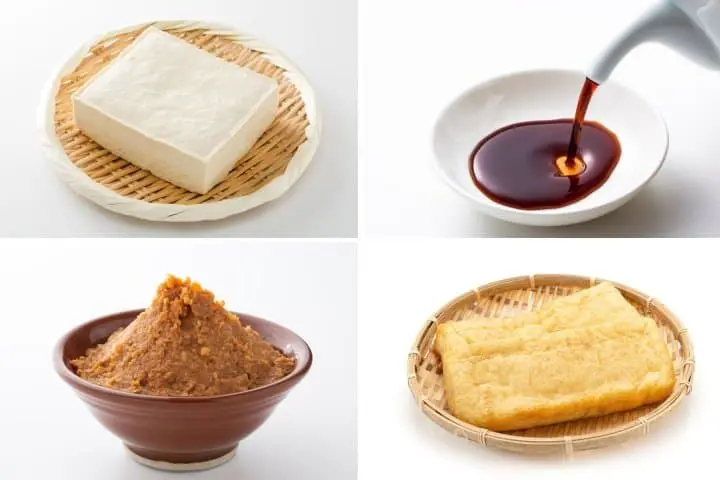
Photos by Pixta
Are you ready for the answer?
All of these products are made from soybeans. Pictured clockwise from left to right are tofu, soy sauce, aburaage (fried tofu), and miso.

Photo by Pixta
Soy sauce and miso are both fundamental condiments in Japanese cuisine. Aburaage, on the other hand, can be an unfamiliar Japanese food for newbies. It is made from tofu that is thinly sliced and deep-fried. It’s often used as an ingredient for miso soup or toppings for udon. Soybeans are high in nutrition and an ingredient consumed daily in Japan.
The next time you visit Japan, try touring a soy sauce or miso factory to discover how these essential condiments are made. In the article below, read about a tour of a soy sauce factory in Niigata Prefecture!
Intermediate Level
Let’s move onto the intermediate portion of the quiz! These questions are more difficult than the previous three.
Q4: What type of food is “Napolitan”?
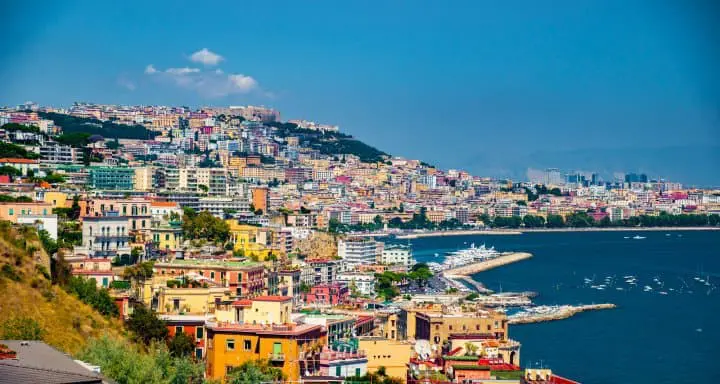
Photo by Pixta
There's a dish called Napolitan in Japan. Just hearing the name alone, you might associate it with Naples in Italy and wonder whether it's Japanese cuisine.
However, it's a bona fide Japanese creation. Below is a picture of the beloved Napolitan.

Photo by Pixta
Napolitan is a pasta dish made by first sauteing meat and vegetables, then mixing it with spaghetti and ketchup. Common ingredients include bacon, sausage, onions, bell peppers, and mushrooms. This dish was created in a Yokohama hotel following the end of World War II, upon which it gained popularity across Japan.
Today, this pasta is a standard menu at cafes and enjoyed by diners of all ages. The media usually hypes its "nostalgic flavor" as something the Japanese cannot live without. Similar to Napolitan spaghetti, there are countless other dishes in Japan that are hard to visualize from their names alone. Venture outside of the standard Japanese cuisine and give these unexpected flavors a try!
Q5: What sound does this represent?
Listen to the audio below. Do you know what sound it represents?

Picture from How To Enjoy Kabukiza Theater Without Buying A Ticket
It’s the sound of frogs croaking. This is one of the tools used in the traditional Japanese theater of kabuki. Shells like the ones pictured above are rubbed together to mimic the sound of croaking frogs.
Other unique tools used in Kabuki theater recreate the sounds of waves, a rowing boat, and much more. We've introduced both these sounds and the tools used to create them in this article.
Nestled in Tokyo's Ginza district is where you'll find the Kabukiza Gallery inside the Kabukiza Theater. This facility is where you can learn about these tools in-depth. Seeing a kabuki stage in-person will leave you with a different impression than viewing a performance on video. Why not add a kabuki performance to your list of activities on your next trip?
Advanced Level
It’s finally time for the expert level! Will you be able to answer these questions correctly?
Q6: Find the mistake in this photo
Find what is wrong in the picture below.
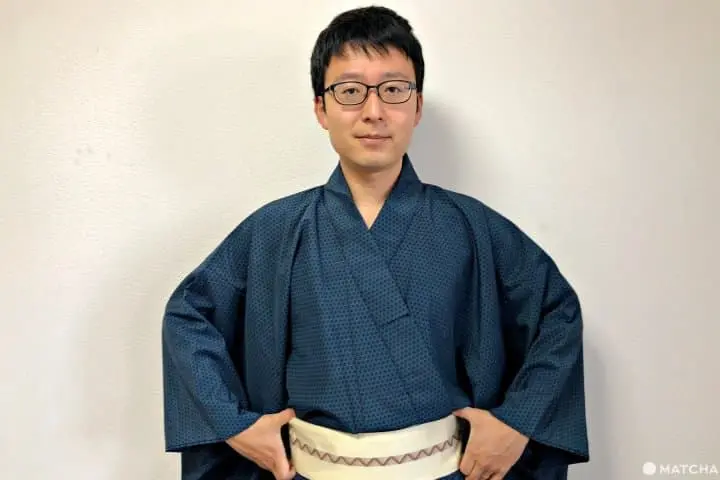
Did you spot it? At first glance, the kimono appears to be worn in the traditional way. However, the front part of the kimono is overlapping in the wrong direction.
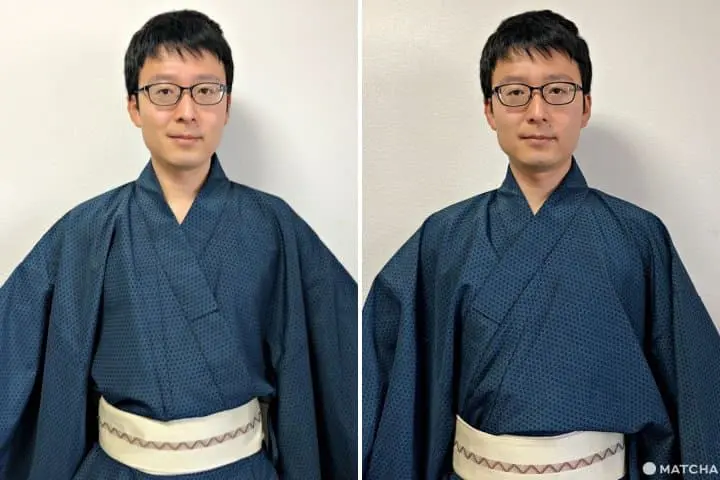
The proper way to wear a kimono is to wrap the right side on top, or migi-mae (left side tucked under the right). This is pictured to the right. You may think it's not a big deal if this mistake is made. However, it’s actually a taboo. This incorrect wrapping method is called hidari-mae (left over right) and is how a kimono is worn by a deceased person.
There are many theories on how the custom of hidari-mae became associated with the dead. During the Nara Period (710 – 794), a law mandated that nobility wear their kimono collars wrapped to the left side over the right. Commoners, on the contrary, wore their collars to the right side over the left at the front. Under this law, the custom of migi-mae became the established way of wearing a kimono. A likely theory is that hidari-mae became used for deceased commoners so they could dress like nobles in the afterlife.
Be aware of these kimono customs if you decide to walk the streets in traditional Japanese garments. Kimono rental shops offer dressing services so tourists can easily rent and wear it the proper way.
Q7: What’s the name of this mountain?
Here’s the final question. Can you name this mountain?

Photo by Pixta
You might think that this question is too simple. The mountain looks like Mt. Fuji, right?
Well, not exactly. This is Mt. Yotei in Hokkaido, but it's the spitting image of Japan's most famous peak—especially when covered in snow.
There are several mountains in Japan that are similar in shape to Mt. Fuji. These picturesque cone-shaped mountains (composite volcanoes) are often nicknamed the Fuji of their respective region because of similarities to this designated World Heritage site.

Photo by Pixta
For example, pictured above is Mt. Kaimon in the south of Kagoshima Prefecture. Adored by locals, the mountain beautifully contrasts with the rapeseed blossoms and ocean. It’s nicknamed “Satsuma Fuji” after Satsuma, the old name of Kagoshima Prefecture. Mount Yotei is also commonly known as "Ezo Fuji" (Ezo is the former name of Hokkaido).
Mt. Fuji is a spiritual symbol for the Japanese. There are also many mountains across Japan that locals take as much pride in as this iconic peak.
Stay Informed and Travel to Japan!
How many questions did you get right in this quiz?
Our Ready For Japan! series provides readers with experiences in Japan they can enjoy from the comfort and safety of their home. Check out other articles in this series and prepare for your future trip here!
Main photo by Pixta
MATCHA Editer.














































![[Coupon Available] Attention Overseas Winter Sports Fans! Nagano's Sports Depot Has Evolved](https://resources.matcha-jp.com/resize/720x2000/2026/01/05-254819.webp)